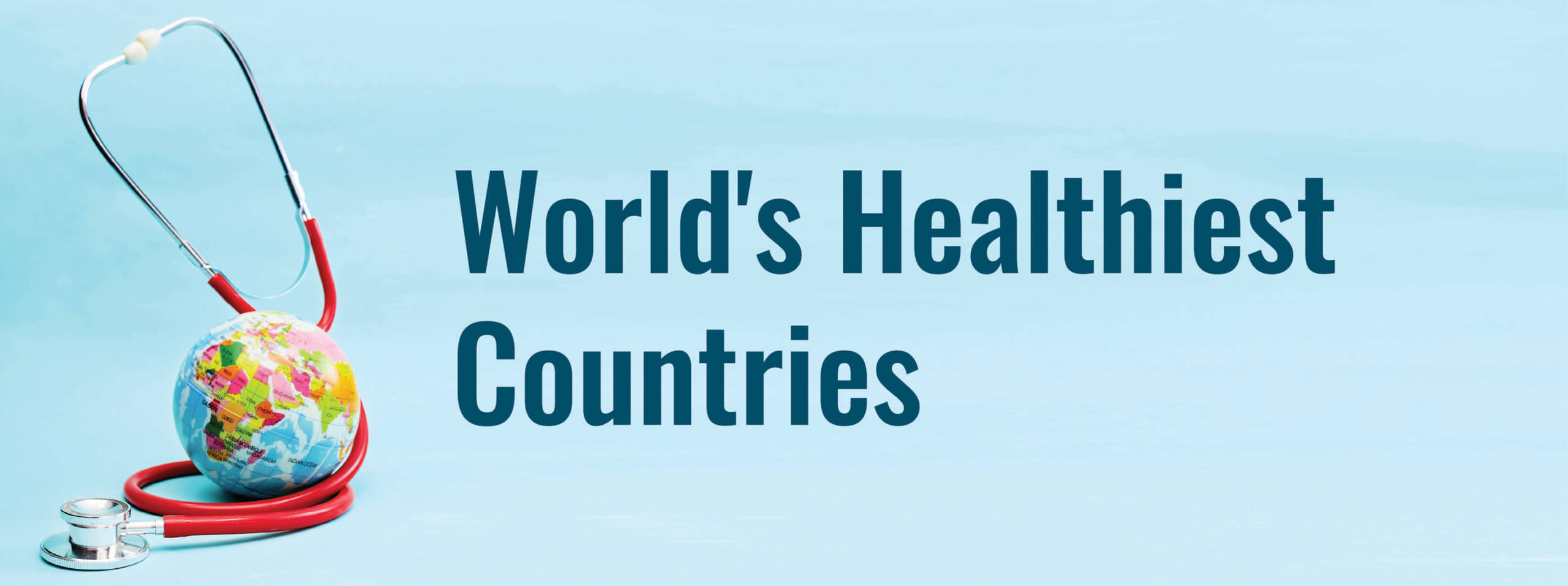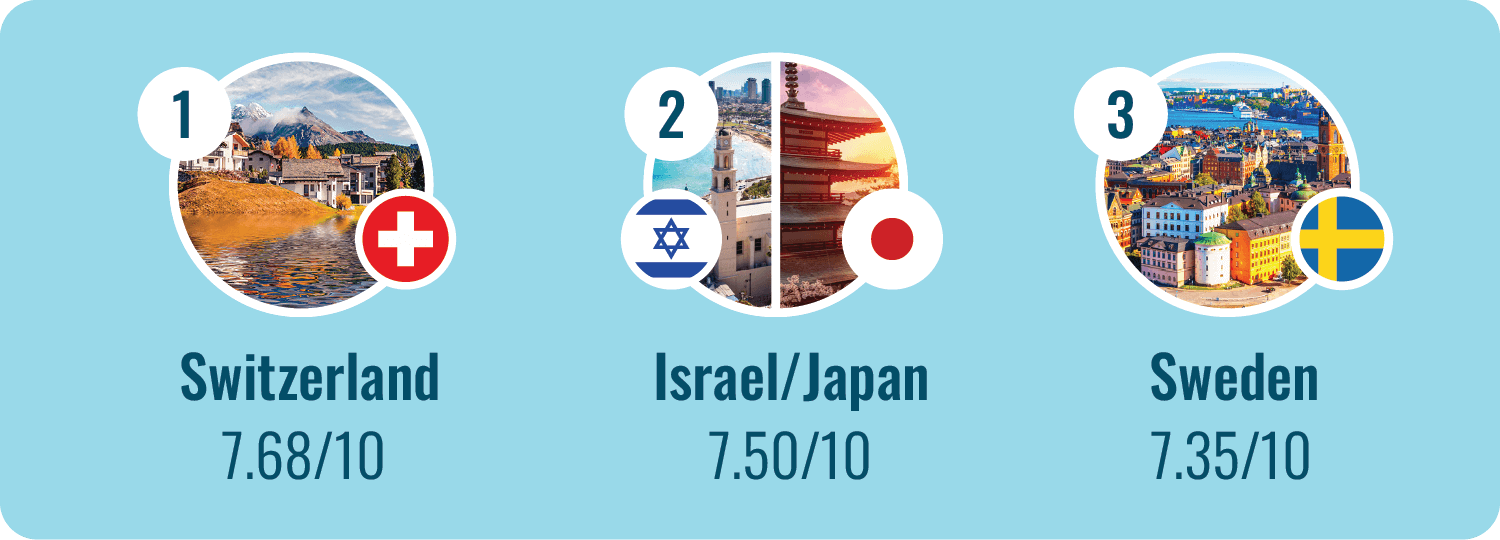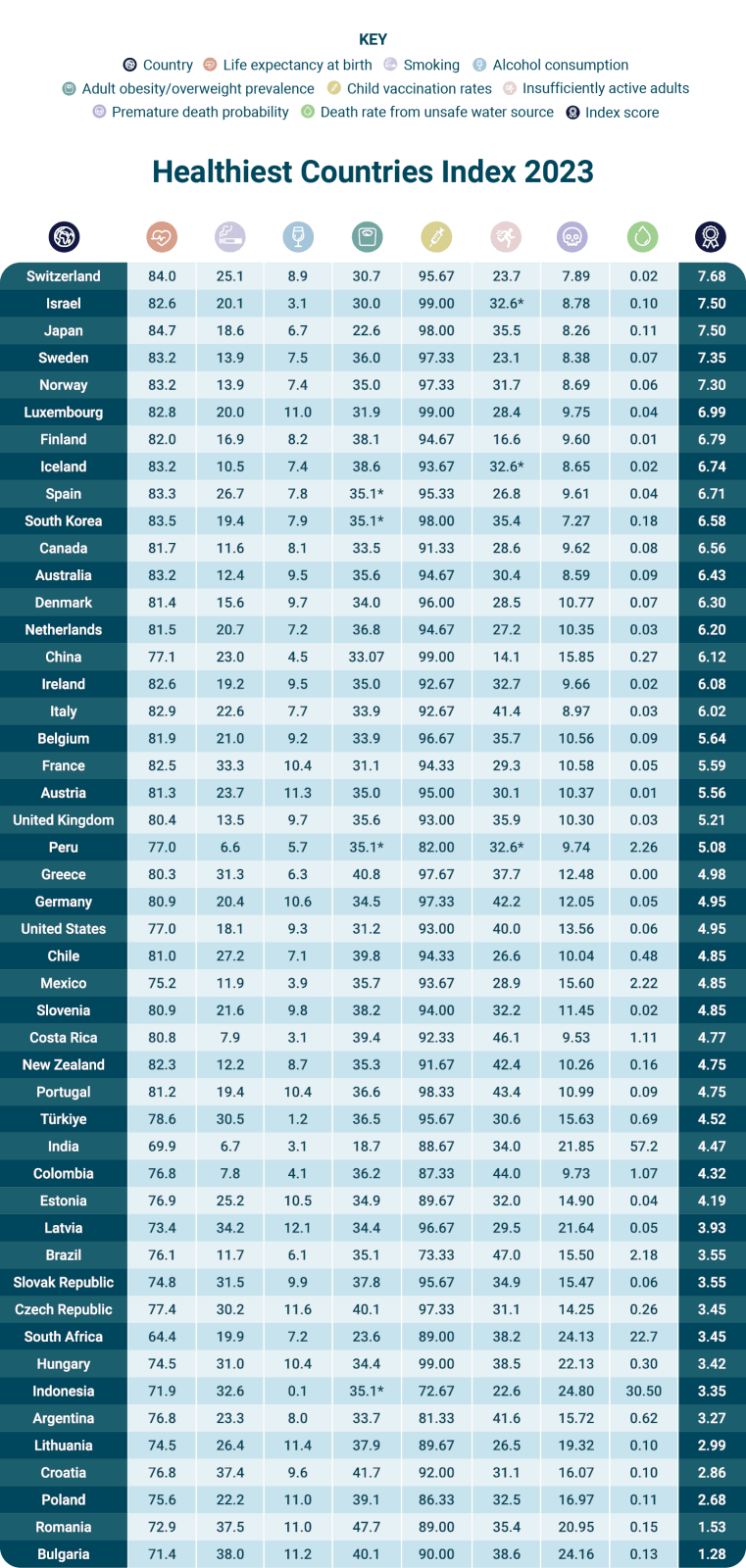The Burrow

There are so many different factors that can impact our health. Beyond our own actions, the resources and cultural practices of a country or region could also have an impact on our health outcomes (this includes things like smoking or drinking alcohol).
This can potentially make staying healthy a challenge.
With this in mind, the health insurance experts at Compare the Market have crunched the numbers for 48 different countries to see how they compare to each other in a range of different health outcome metrics.
Humans are not impervious to harm, and even those of us who are fit and healthy will need to rely on healthcare services to make sure we’re looking after ourselves. Dentists, optometrists, psychologists, physiotherapists and other types of services can provide important care to help us improve our wellbeing and live healthier lives.
Whether it be services outside of hospital or in-patient planned surgeries, healthcare can make a big difference to our quality of life.
Health insurance can help you pay for out-of-hospital extras services or in-patient hospital treatment – or both, depending on the policy you choose. This helps you choose where you seek treatment, who treats you (subject to availability), avoid Australia’s public waiting list for medically necessary surgery, while also contributing towards the cost of specific treatments that you need, in accordance with what’s included in your policy.
Some policies can even cover gym memberships and fitness classes, encouraging us to be more active and improve our fitness. If this benefit is included on your policy, you will need to meet your funds requirements before claiming. This usually requires you to provide your health fund with a letter from your doctor.
Compare the Market’s General Manager of Health, Anthony Fleming, notes that health insurance can provide great value for people looking to improve their health.
“There are so many services that health funds can pay a benefit towards, from dental, optical, dietetics, physiotherapy and gym memberships for medical purpose, to medically necessary in-hospital treatments and surgeries relating to cancer, heart health and joint replacement,” says Fleming. “Depending on what people wish to have included on their policy, they can use that throughout the year as needed, in accordance with their policies waiting periods, coverage limits and claiming requirements.”
“Having health insurance provides greater choice and more options for important medical care that can have a huge impact on your individual quality of life. As there are lots of different policies with varying levels of coverage, it’s important to consider your options to find a policy that better suits your needs.”
To create the index, we gathered data on the following eight metrics for 48 different countries: life expectancy at birth, smoking prevalence, alcohol consumption, the prevalence of overweight and obese adults in the population, child vaccination rates, insufficiently activity levels among adults, the chance of dying prematurely, and the death rate from unsafe drinking water.
Life expectancy itself can be influenced by a variety of factors, including the quality of healthcare, food, plus living and work conditions in a country. Smoking negatively affects our health and is a risk factor for cancer, while alcohol consumption can also negatively affect our health. On 4 January 2023 the World Health Organization (WHO) stated that there was no safe amount of alcohol that doesn’t affect our health.1
Being overweight and obese increases risk factors for negative health outcomes, so we looked at the prevalence of overweight and obese adults in the population, as well as insufficient activity levels among adults. Our index also looked at child vaccination rates for Diphtheria, Tetanus and Pertussis, which are infectious diseases commonly vaccinated against in children under one vaccine.2
The last two factors were the probability of premature death (due to various noncommunicable diseases, according to WHO data), and the death rate from unsafe drinking water, which are both big indicators of specific health needs and outcomes in a country.
Each nation was given a score for each metric based on how they compared to each other, before all these scores were averaged together to create an index score out of 10. The higher the score, the better health outcomes a country has, according to the data.
Read more about how we calculated this index in our methodology.

Switzerland was the highest ranked country in our index, as they performed very highly across the majority of the eight metrics, including the second-lowest probability of premature death (7.89%), as well as a low death rate from unsafe water sources, low levels of adult obesity, and the second-highest life expectancy at 84 years.
Israel and Japan both tied for second place with equal scores of 7.5/10. Japan had the best life expectancy at 84.7 years, the second-smallest percentage of overweight adults at 22.6% and third-lowest chance of premature death at 8.26%. In contrast, Israel had one of the best child vaccination rates at 99% (a figure shared by Luxembourg, China and Hungary) and the third-lowest alcohol consumption at 3.1L per capita, besides also scoring well in other metrics.
Sweden claims third place on our index with a score of 7.35/10 by doing well in many metrics. Sweden had the fifth-best life expectancy at 83.2 years (the same as Norway, Iceland and Australia), the fifth-smallest proportion of insufficiently active adults (23.1%), as well as the fourth-smallest chance of premature death at 8.38%.


Japan had the highest life expectancy at birth for both sexes at 84.7 years, based on the latest available data from the Organisation for Economic Co-operation and Development (OECD). This was a difference of 20.3 years above the country with the lowest life expectancy, South Africa.

The country with the smallest percentage of the adult population that smoke tobacco is Peru, where only 6.6% of the population reported smoking, according to WHO data. This is 31.4% lower than the country with the largest smoking adult population, Bulgaria.

Indonesia has an incredibly low average alcohol consumption per capita. As noted by the Indonesian Ministry of Tourism, alcohol is strictly prohibited and regulated in accordance with Islamic law, and completely banned in the province of Aceh.3 Outside of hotels and designated drinking areas for tourists, alcohol is hard to come by and strictly controlled. In contrast, Latvia had the highest alcohol consumption of 12.1L per capita.

India had the smallest percentage of adults listed as overweight or obese at 18.7%, according to data from the World Obesity Federation. Romania had the highest at 47.7% – a difference of 29% between the two extremes.

Four countries, Israel, Luxembourg, China and Hungary, had an average child vaccination rate of 99% across three common vaccines: DTP1 (Diphtheria, Tetanus and Pertussis), MCV1 (Measles) and RCV1 (Rubella), according to the latest available data from the United Nations International Children’s Emergency Fund (UNICEF). On the other end of the scale, Indonesia had the smallest child vaccination rate of 72.67%.

China is the nation with the smallest proportion of adults with insufficient activity levels (the WHO recommends 150 to 300 minutes of moderate physical activity or 75-100 minutes of vigorous physical activity per day).4 While just 14.1% of China’s adult population is estimated to be insufficiently active, Brazil has the most with 47% of the adult population struggling to commit to the WHO’s recommended activity levels.

South Korea had the lowest chance of premature death from noncommunicable diseases such as diabetes, cancer, chronic respiratory diseases and cardiovascular diseases, based on adults aged 30 to 70. These adults have a 7.27% chance of premature death. In contrast, Indonesia had the highest chance of premature death from these causes at 24.8%.

The country with the lowest death rate from unsafe water was Greece, which beat out Austria and Finland (where the death rate was 0.01 per 100,000) with 0 deaths per 100,000 people. It is possible that people in Greece do die from unsafe drinking water, but the number is so low that it does not appear in a per capita rate of 100,000. In contrast, India had the highest death rate from unsafe water at 57.2 per 100,000 people.
Each of the 48 countries was given a score out of 10 for each metric, with 10 representing the best score and 0 representing the worst score for that metric. For some measures, a high statistic was given a low score, but other metrics were scored highly based on a high statistic, depending on the context of the specific figure. These scores were then averaged together, creating an indexed score that countries would be ranked by, with the highest score being better.
Data for each metric was taken from the following sources and scored accordingly:
* Some countries were missing a particular data point, so an average of the result from all other countries was used for the purpose of calculating an index.
Sources:
1 No level of alcohol consumption is safe for our health. The World Health Organization. 2023.
2 DTaP (Diphtheria, Tetanus, Pertussis) VIS. Centers for Disease Control and Prevention, U.S. Department of Health & Human Services. 2021.
3 Local Law. Wonderful Indonesia, Ministry of Tourism, Republic of Indonesia. 2023.
4 Physical activity. World Health Organization. 2022.